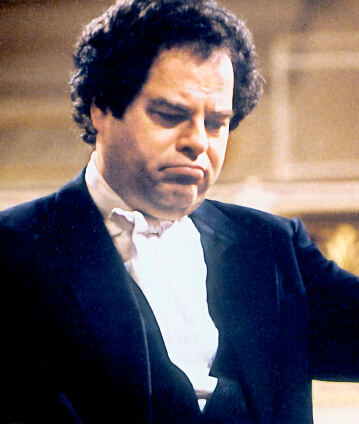Itzhak Perlman and Daniel Barenboim perform Beethoven’s Violin Concerto

In 1992, Daniel Barenboim and Itzhak Perlman gave four concerts with the Berliner Philharmoniker at the Schauspielhaus am Gendarmenmarkt – the orchestra’s temporary home at the time, as the Philharmonie Berlin had to be extensively renovated. The two programmes featured the violin concertos by Beethoven and Brahms. They were each complemented by less familiar works, and so on the first two evenings Liszt’s rarely performed Dante Symphony formed a delightful contrast to Beethoven’s classic of the violin repertoire.
Daniel Barenboim and Itzhak Perlman have been friends and colleagues for practically all of their lives. In the spring of 1992 they gave four concerts with the Berliner Philharmoniker in the Schauspielhaus am Gendarmenmarkt, while the orchestra’s usual home was being renovated. Central to the two programmes that were presented twice within a week were the violin concertos of Beethoven and Brahms. In both cases the programme was rounded out by other, lesser-known works. On the first two evenings, Liszt’s rarely played Dante Symphony provided a delightful contrast to Beethoven’s repertory classic in D major.
Beethoven first toyed with the idea of writing a violin concerto around 1790, towards the end of his years in Bonn. And in the wake of his two Romances for violin and orchestra, which may be regarded as preliminary studies for the concerto, he completed his only violin concerto in 1806. Now regarded as a milestone in the history of the violin repertory, it was not a success when premiered by Franz Clement. Observers felt that it contained “a host of ideas that do not belong together and that are piled up on top of each other”. Time did not yet look favourably on a work that is elaborated along symphonic lines. Not until 1844, when the twelve-year-old violin prodigy Joseph Joachim – later one of Brahms’s closest friends – gave his acclaimed London debut and scored a great personal success with the work did it embark on its triumphal journey through the concert halls of the world.
These concerts in Berlin in 1992 marked the twentieth anniversary of American violinist Itzhak Perlman’s debut with the Berliner Philharmoniker – he had first appeared with the orchestra in 1972, performing Tchaikovsky’s Violin Concerto, also under Barenboim’s direction. In comparison to those of Tchaikovsky’s late Romantic masterpiece, the difficulties of Beethoven’s concerto lie – in Perlman’s view – chiefly in the transparency of the orchestral writing: “There’s nowhere to hide.” For Perlman, it is “a great, great piece” which he “could play forever, 10 times in a row, and never get tired of it. Because every time I play it, there’s something new to discover in this piece.”
© 1992 EuroArts Music International
Artists
Our recommendations
- A Beethoven evening with Daniel Barenboim, Itzhak Perlman and Yo-Yo Ma
- Itzhak Perlman and Daniel Barenboim perform Brahms’s Violin Concerto
- Season finale at the Waldbühne with Daniel Barenboim
- 2018 New Year’s Eve Concert with Daniel Barenboim
- Daniel Barenboim conducts the 1997 Europakonzert from Versailles
- Daniel Barenboim conducts Verdi